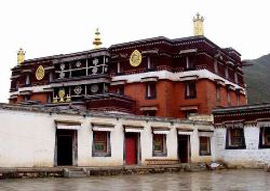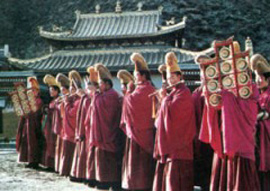 The best time to see the monastery is during the Tibetan festivals that are held at various times throughout the year, according to the traditional lunar calendar. The best of these has to be the Great Prayer Festival (Monlam), which is held around the end of February or early March, 3 days after the Tibetan New Year. The best time to see the monastery is during the Tibetan festivals that are held at various times throughout the year, according to the traditional lunar calendar. The best of these has to be the Great Prayer Festival (Monlam), which is held around the end of February or early March, 3 days after the Tibetan New Year.
The Yellow Hat Sect (Gelukpa) of Tibetan Buddhism presently has six very important monasteries in China. Most are situated in Tibet (the Ganden, Sera and Drepung monasteries in the Lhasa area and the Tashilhunpo Monastery in Shigatse), one is in Qinghai Province’s Huangzhong (the Ta’er Monastery), and the last is in the small town of Xiahe (the Labrang Monastery). This last monastery is situated around one and a half kilometers west of the bus station, along the main road in town. In terms of size it is second only to the Potala Palace in Lhasa and it is so called from the Tibetan Labrang meaning the place where the Buddhist Palace stands.
The Labrang Monastery (Labuleng si) has had its fair share of woes and golden times. It was built in 1709 by a monk from the nearby village of Ganjia named E’angzongzhe, who was to become the first of the monastery’s Living Buddhas (Jiemuyang). The place was to live in relative peace until the 1920s when the Muslims and Tibetans had numerous battles in and around this region, turf wars that were both bloody and prolonged. Again in the Cultural Revolution (1966-76), with Mao’s indictments against non-communist religion and traditional customs, the region was in chaos. Many of the over 4000 monks disappeared and many of the temples and buildings were raised. The monastery was temporarily shut down, and was not reopened until 1980, with the ascendance of Deng Xiaoping to power. Nowadays there are around 2000 monks, mainly from Qinghai, Gansu, Sichuan, and Inner Mongolia, and reconstruction and extension of the monastery is being done rapidly. The present head monk, 3rd in religious importance behind the Dalai and Panchen Lamas, is the sixth incarnation of the Jiemuyang.
The monastery consists of 18 resplendent halls, six prestigious Buddhist institutes (the Institute of Esoteric Buddhism, the Higher & Lower Institute of Theology, the Institute of Medicine, the Institute of Astrology and the Institute of Law), and about 500 bedrooms for both the living Buddhas and ordinary monks. In total the monastery holds over 60,000 Tibetan sutras and thousands of rare Buddhist relics, including a statue of the most famous Tibetan king, Songtsen gampo.
There are two halls that stand out here, the Main Hall and the Shouxi Prayer Hall.
The Main Hall bears a horizontal wooden board inscribed with three large Chinese characters Juehui si, meaning a temple where self discovery is made. On religious occasions the hall may hold up to 4,000 people for prayer.
Of the six prayer halls in the Labrang, the Shouxi Prayer Hall is the largest in size, with a total of six storeys rising to 20 meters. Within is housed a mammoth statue of Sakimonia, and the whole hall, with a golden dragon on its roof and silver lions on its walls, is the most grandiose structure here.
The temple has many good features and, beyond taking the obviously requisite tour, a stroll around the grounds is both peaceful and enjoyable. The majority of the best sights of the temple are to be found to the north of the main road, through the obvious entrance that approximately bisects the road between the prayer wheel circle. A good activity is to follow, clockwise, the throngs of Buddhists that make the slow trek along the roofed Prayer Wheels, that encircle the entire monastery. The hills above are also a good area to get away from the crowds, although you may want to avoid the sacrilege of stumbling upon a sky burial.
The best time to see the monastery is during the Tibetan festivals, that are held at various times throughout the year, according to the traditional lunar calendar. The best of these has to be the Great Prayer Festival (Monlam), that is held around the end of February or early March, 3 days after the Tibetan New Year. This is a time for prayer, processions and festivities such as the display of butter sculptures (that are still considered medicinal food, many years after they are made).
How to get there Turn right out of the bus station onto the main road. The monastery entrance is on the right about 1.5km from Xiahe.
Cost General entry is free. Tours will cost you 40 yuan.
Tour Information Entry into the main temple is by tour only. Some of the monks speak passable English and will show you around the Institute of Medicine, the Ser Kung Golden Temple, the Prayer Hall and the museum. The ticket office is on the right of the monastery park (not selling tickets between noon and 230pm).
Opening hours 9am-12am, 230pm-430pm for a guided tour and until 430pm for general visitors. |
